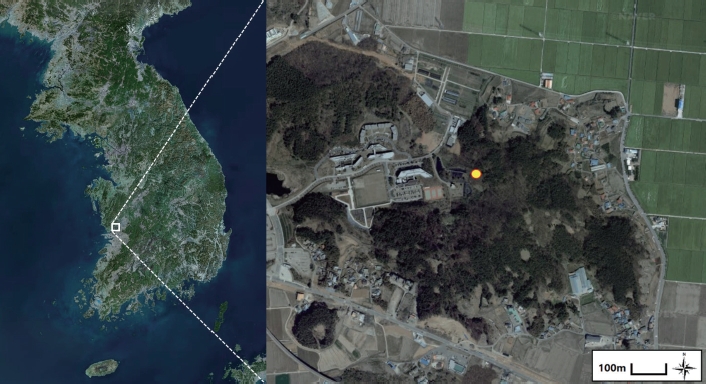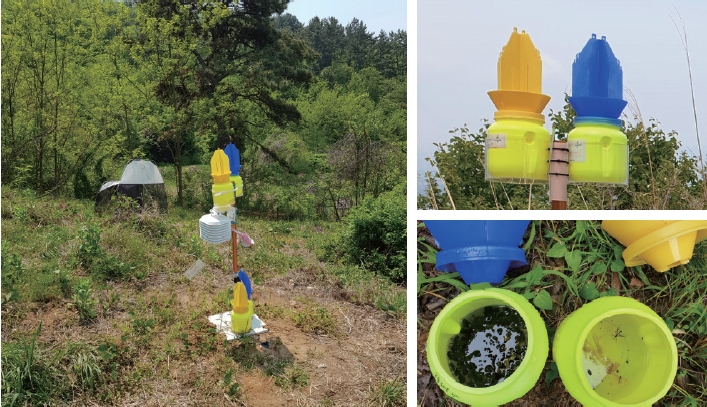Articles
- Page Path
- HOME > GEO DATA > Volume 6(1); 2024 > Article
-
Original Paper
서천 마을숲 야생벌의 다양성에 대한 정량적 연구 -
이상훈1,*
 , 권오창2
, 권오창2 , 유동수3
, 유동수3 , 안정섭4
, 안정섭4 , 안나현5
, 안나현5
- Exploring Wild Bees Diversity in Seocheon Maeul-Soop: A Quantitative Study
-
Sanghun Lee1,*
 , Ohchang Kwon2
, Ohchang Kwon2 , Dong Su Yu3
, Dong Su Yu3 , Jeong-Seop An4
, Jeong-Seop An4 , Na-Hyun Ahn5
, Na-Hyun Ahn5
-
GEO DATA 2024;6(1):1-7.
DOI: https://doi.org/10.22761/GD.2024.0003
Published online: March 26, 2024
1팀장, 국립생태원, 경상남도 창녕군 이방면 이산길 38, 50303, 대한민국
2프리랜서, 충청남도 홍성군 구항면 구성남로912번길 49-22, 32215, 대한민국
3농업연구사, 국립농업과학원, 전라북도 전주시 덕진구 농생명로 300, 54875, 대한민국
4전임연구원, 국립생태원, 충청남도 서천군 마서면 금강로 1210, 33657, 대한민국
5연구원, 국립생태원, 충청남도 서천군 마서면 금강로 1210, 33657, 대한민국
1Team Leader, National Institute of Ecology, 38 Isan-gil, Ibang-myeon, Changnyeong-gun, 50303 Gyeongsangnam-do, South Korea
2Freelancer, 49-22 Guseongnam-ro 912beon-gil, Guhang-myeon, Hongseong-gun, 32215 Chungcheongnam-do, South Korea
3Researcher, National Institute of Agricultural Sciences, 300 Nongsaengmyeong-ro, Duckjin-gu, Jeonju, 54875 Jeollabuk-do, South Korea
4Associate Researcher, National Institute of Ecology, 1210 Geumgang-ro, Maseo-myeon, Seocheon-gun, 33657 Chungcheongnam-do, South Korea
5Researcher, National Institute of Ecology, 1210 Geumgang-ro, Maseo-myeon, Seocheon-gun, 33657 Chungcheongnam-do, South Korea
- Corresponding Author Sanghun Lee Tel: +82-55-530-5511 E-mail: sanghunlee@nie.re.kr
Copyright © 2024 GeoAI Data Society
This is an Open Access article distributed under the terms of the Creative Commons Attribution Non-Commercial License (http://creativecommons.org/licenses/by-nc/4.0/) which permits unrestricted non-commercial use, distribution, and reproduction in any medium, provided the original work is properly cited.
- 375 Views
- 40 Download
Abstract
- Wild bees are important pollinators in the ecosystem, and it is important to monitor their abundance and diversity to characterize and conserve these pollinators. In this study, wild bees were collected from a Maeul-soop in Seocheon-gun, Chungcheongnam-do, Republic of Korea for 2 years from February 2019 to October 2020. From the survey, a total of 3,258 wild bees from 9 families and 57 species were collected over 2 years in the Maeul-soop. The most dominant species was the Andrena kaguya, followed by the Apis mellifera, the Eucera spurcatipes, the Seladonia aeraria, and the Lasioglossum sibiriacum. Monthly changes in the number of species and populations show that the number of species increased from February and peaked in August, and the population peaked in April and then decreased. In addition, in the list of wild bee species collected over the past 2 years, the Apidae was the largest with 16 species, followed by the Halictidae with 13 species and the Megachilidae with nine species. However, although there is only one species of Andrena kaguya in the Andrenidae, its population is 2,084, which is the largest among all wild bees investigated in this study. The results of this study will be useful in understanding the impact of pollinating insects due to climate change in the future.
- 기후 변화는 전 세계 여러 곳에서 나타나고 있으며 현재도 진행 중이다. 지난 100년간 전 세계 평균 기온은 약 0.6°C 상승한 데 비해 우리나라의 경우 두 배가 넘는 약 1.5°C 상승하여 빠르게 기후 변화가 진행되고 있다(National Institute of Meteorological Sciences, 2018). 특히 기후 변화로 인한 지구온난화가 이대로 진행된다면 21세 후반에는 20세기 후반에 비해 평균 기온은 약 4.6°C 상승하고 강수량은 약 30% 이상 증가할 것으로 예측되고 있으며, 극한 강수의 경우 현재보다 훨씬 심해질 것으로 예측된다(Lee and Bae, 2012; Lee et al., 2013). 이러한 지구온난화는 인간생활뿐만 아니라 생태계의 많은 구성 요소에 영향을 미치고 있다. 생태계의 많은 구성 요소들 가운데, 특히 화분매개곤충의 감소 및 절멸 위기 및 외래종 유입에 따른 종 다양성 변화 등 많은 영향들이 발생하고 있다. 특히 지구온난화로 인한 화분매개곤충의 감소는 다양한 지역에서 문제가 되고 있으며, 미국의 경우 2017년 뒤영벌류(Hymenoptera, Apidae, Bombus) 개체 수의 급격한 감소로 인해 멸종위기종으로 지정하여 야생벌의 보전을 추진하고 있다(Shell and Rehan, 2019). 화분매개곤충은 생태계 건강성 유지에 중요한 역할을 할 뿐만 아니라 농업 및 수익 창출에 기여하고 있다. 주요한 작물의 85%가 동물의 수분에 의존하며, 결국 화분매개곤충의 감소는 농작물 생산 감소를 야기하여 인류의 식량자원 확보에 큰 타격을 미칠 것으로 예측하고 있다(Potts et al., 2010). 여러 화분매개곤충 가운데 대표적인 화분매개곤충으로 알려져 있는 양봉꿀벌(Apis mellifera)을 포함한 꽃벌류(Hymenoptera, Apoidea, Apiriformes)는 농업에 많이 활용되고 있다.
- 우리나라의 경우 야생벌류에 대한 연구는 야생벌의 형태적 특징(Frunze et al., 2022; Nguyen et al., 2020) 등 일부 이루어지고 있으며, 기후 변화 영향 등에 대한 연구는 많이 부족한 상태이다. 국내 과수원이나 야생 초지대의 과실수 및 현화식물을 방문하는 다양한 곤충들 중에 파리목, 딱정벌레목, 나비목, 노린재목보다 벌목이 가장 많이 방문하고 있는 것으로 알려져 있다(Choi and Jung, 2015). 특히 전국 51개 지점에 대한 야생벌류의 전국 분포 현황에 대한 연구가 있으며, 이 연구에서는 미래 기후 변화 영향으로 인한 서식지 예측 결과 북쪽으로 이동하는 것으로 나타났다(Yu et al., 2022). 미래 기후 변화로 인한 영향을 예측하고 대응하기 위해서는 전국적인 분포뿐만 아니라 지역의 정량적 연구가 체계적으로 이루어져야 한다.
- 이렇게 화분매개곤충은 생태계뿐만 아니라 농업활동 등에 중요한 역할을 하고 있으므로 화분매개곤충에 대한 정량적 조사를 통한 종다양성 및 풍부도에 대한 연구가 필요하다. 본 연구는 일반적인 마을숲에서 서식하고 있는 야생벌의 종다양성을 파악하기 위하여 충청남도 서천군 마서면의 마을숲에서 야생벌을 채집하여 계절별 종 및 개체 수를 정량적으로 파악하였다.
1. 서론
- 산림청의 산림임업용어사전의 정의에 의하면 산림 문화의 보전과 지역 주민의 생활환경 개선 등을 위하여 마을 주변에 조성/관리하는 산림 및 수목을 말하며 전통적으로 마을 사람들의 삶과 관련하여 마을 주변에 조성되어 온 숲을 말한다(Korea Forest Service, 2024). 본 연구에서는 충청남도 서천군 마서면의 작은 야산이 있는 곳을 선정하였으며 조사지 주변은 논, 밭, 주거지 등 전형적인 마을의 가운데 위치하는 마을숲을 선정하였다. 마을숲에는 리기다소나무와 밤나무가 우점하고 있으며 소나무, 상수리나무, 아카시나무 등이 서식하고 있다. 조사 지점 주변의 하층에는 칡, 개망초, 잔디 등이 서식하고 있다. 또한 조사 지점은 콘크리트 건물이 있는 곳에서 50 m 이상 떨어진 인간의 간섭이 비교적 덜 한 곳으로, 햇볕이 잘 들어오는 개활지를 선정하였다(Fig. 1).
- 야생벌은 생태계 내에서 중요한 수분매개체이며 이러한 수분매개체의 특징을 분석하고 보전하기 위해서는 야생벌의 풍부도와 다양성을 모니터링하는 것이 중요하다. 본 연구에서는 야생벌을 채집하기 위하여 베인트랩(blue and yellow vanes trap)을 사용하였다(Acharya et al., 2022). 베인트랩은 여러 가지 색이 있으며 그중에서 가장 벌이 많이 잡히는 파란색과 노란색을 사용하여 2019년과 2020년의 2월 말부터 10월 말까지 5-9일 간격으로 2년간 야생벌을 채집하였다(Fig. 2). 트랩은 1.5 m 기둥에 위아래로 2개씩 설치하여 채집을 진행하였다.
2. 대상 지역 및 연구 방법
- 본 연구에서 2년 동안 채집된 벌목 곤충은 총 9과 57종 3,258개체로 나타났으며, 2019년은 7과 40종 1,380개체, 2020년은 9과 42종 1,878개체로 나타났다. 2년간 채집된 야생벌의 월별 종 수 및 개체 수를 살펴보면 2019년보다 2020년이 종 수 및 개체 수가 많았다. 또한 평균적으로 종 수는 2월부터 증가하기 시작하여 8월에 피크를 보이고 다시 줄어드는 경향을 보이고 있었으며, 개체 수는 4월에 피크를 보이고 서서히 줄어드는 경향이 나타났다(Table 1). 특히 개체 수의 경우 4월이 전체 개체 수의 50%가 넘게 차지하고 있었다.
- 2년간 채집된 야생벌 중 가장 많이 출현한 5종은 애꽃벌과의 꼬마애꽃벌이 2,084개체로 가장 많았으며, 다음으로 꿀벌과의 양봉꿀벌과 수염줄벌이 715개체와 141개체, 꼬마꽃벌과의 구리꼬마꽃벌과 옅은광택꼬마꽃벌이 37개체와 34개체였다. 특히 애꽃벌과의 꼬마애꽃벌은 전체 개체 수의 64%를 차지하였다. 또한 2년간 채집된 야생벌의 종과 개체 수를 살펴보면, 꿀벌과가 16종으로 가장 많았으며 그중에서 양봉꿀벌이 715개체로 가장 많았다. 다음으로 꼬마꽃벌과가 13종으로 많았으며 그중에서 구리꼬마꽃벌이 37개체로 많이 채집되었다. 그리고 가위벌과가 9종으로 많았으며 그중에서 장미가위벌이 7개체로 많이 나타났다. 애꽃벌과의 경우 꼬마애꽃벌 1종만 관찰할 수 있었지만 개체 수는 2,084개체로 본 연구에서 조사된 모든 야생벌 중에 가장 많이 나타났다(Table 2).
- 본 연구에서는 우리나라의 일반적인 마을숲에 서식하는 야생벌의 다양성에 대하여 정량적 조사를 실시하였다. 조사된 결과는 향후 기후 변화로 인한 수분매개곤충의 영향을 파악하는 데 유용하게 쓰일 것이다.
3. 결과
-
Conflict of Interest
Sanghun Lee has been an Editorial Board of GEO DATA; however, he was not involved in the peer reviewer selection, evaluation, or decision process of this paper. Otherwise, no other potential conflicts of interest relevant to this paper were reported.
-
Funding Information
This study was funded by the project, “Wetlands research”, grant numbers NIE-A-2024-18.
-
Data Availability Statement
The data that support the findings of this study are openly available in [EcoBank] at http://doi.or.kr/10.22756/GEO.20240000000842.
Notes
- Acharya RS, Burke JM, Leslie T, Loftin K, Joshi NK (2022) Wild bees respond differently to sampling traps with vanes of different colors and light reflectivity in a livestock pasture ecosystem. Sci Rep 12:9783ArticlePubMedPMCPDF
- Choi SW, Jung C (2015) Diversity of insect pollinators in different agricultural crops and wild flowering plants in Korea: literature review. J Apic 30(3):191–201Article
- Frunze O, Kim JE, Kim D, et al (2022) Morphometric characterization of newly defined subspecies Apis cerana koreana (Hymenoptera: Apidae) in the Republic of Korea. Korean J Appl Entomol 61(3):399–408
- Korea Forest Service (2024) Dictionary of Forestry Terms Korea Forest Service; https://www.forest.go.kr/kfsweb/kfi/kfs/mwd/selectMtstWordDictionaryList.do?mn=NKFS_04_07_03 Accessed 18 Mar 2024
- Lee S, Bae DH (2012) Local effects of climate change over South Korea with a high-resolution climate scenario. Clim Res 54(1):85–93Article
- Lee S, Bae DH, Cho CH (2013) Changes in future precipitation over South Korea using a global high-resolution climate model. Asia-Pacific J Atmos Sci 49(5):619–624ArticlePDF
- National Institute of Meteorological Sciences (2018) 100 Years of Climate Change on the Korean Peninsula. National Institute of Meteorological Sciences, Jeju, p. 1–15
- Nguyen HN, Im MH, Jeong HK (2020) Description of the Japanese plum sawfly larva Monocellicampa pruni (Hymenoptera: Tenthredinidae) in South Korea. Korean J Appl Entomol 59(4):443–449
- Potts SG, Biesmeijer JC, Kremen C, et al (2010) Global pollinator declines: trends, impacts and drivers. Trends Ecol Evol 25(6):345–353ArticlePubMed
- Shell WA, Rehan SM (2019) Invasive range expansion of the small carpenter bee, Ceratina dentipes (Hymenoptera: Apidae) into Hawaii with implications for native endangered species displacement. Biol Invasions 21(4):1155–1166ArticlePDF
- Yu DS, Kwon OC, Shin M, Kim JK, Lee SH (2022) Effects of climatic factors on the nationwide distribution of wild Aculeata (Insecta: Hymenoptera). Korean J Environ Ecol 36(3):303–317Article
References
Appendix
| Sort | Field | Subcategory#1 | Subcategory#2 |
|---|---|---|---|
| Essential | *Title | Quantitative Study of Wild Bees Diversity in Seocheon Maeul-soop | |
| *DOI | http://doi.or.kr/10.22756/GEO.20240000000842 | ||
| *Category | Biota | ||
| *Temporal Coverage | 2 years | From 2019 to 2020 | |
| *Spatial Coverage | WGS84 Coordinates | Point | |
| Mt. Hallasan | |||
| Latitude 33° 01’ 47.27˝ | |||
| Longitude 126° 43’ 36.34˝ | |||
| *Personnel | Name | Sanghun Lee | |
| Affiliation | National Institute of Ecology | ||
| sanghunlee@nie.re.kr | |||
| *CC License | CC BY-NC | ||
| Optional | *Project | Basic survey on inland wetlands (‘24) | |
| *Instrument | Vanes trap |
Figure & Data
References
Citations


 GAIDAS
GAIDAS


 PubReader
PubReader ePub Link
ePub Link Cite
Cite



